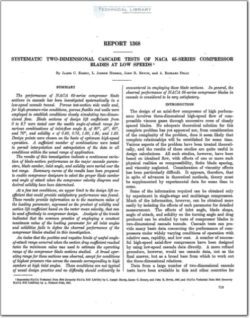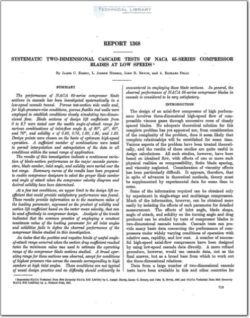NACA-Report-1368

- Version
- 353 Downloads
- 6.42 MB File Size
- 1 File Count
- December 4, 2015 Create Date
- December 4, 2015 Last Updated
National Advisory Committee for Aeronautics, Report - Systematic Two-Dimensional Cascade Test of NACA 65-Series Compressor Blades at Low Speeds

The performance of NACA 65—series compressor blade
sections in cascade has been investigated systematically in a
low-speed cascade tunnel. Porous test-section side walls and,
for high-pressure-rise conditions, porous flevible end walls were
employed to establish conditions closely simulating two-dimen-
sional flow. Blade sections of design lift coezficients from
0 to 3.7 were tested over the usable angle-of-attaclc range for
various combinations of inlet—flow angle [31 of 30°, 45°, 60°,
and 70°, and solidity a' of 0.50, 0.75, 1.00, 1.25, and 1.50.
Design points were chosen on the basis of optimum high-speed
operation. A suficient number of combinations were tested
to permit interpolation and extrapolation of the data to all
conditions within the usual range of application.
The results of this investigation indicate a continuous valiaw
tion of blade-section performance as the major cascade param—
eters, blade camber, inlet angle, and solidity were varied over the
test range. Summary curves of the results have been prepared
to enable compressor designers to select the proper blade camber
and angle of attach: when the compressor velocity diagram and
desired solidity have been determined.
At a few test conditions, an upper limit to the design lift co—
efi‘icient that could provide satisfactory performance was found.
These results provide information as to the maximum value of
the loading parameter, expressed as the product of solidity and
section lift coefi'icient based on the vector mean velocity, that can
be used efi'ectively in compressor design. Analysis of the trends
indicated that the common practice of employing a constant
maximum value of the loading parameter for all inlet angles
and solidities fails to define the observed performance of the
compressor blades studied in this investigation.
An indeic that the positive and negative limits of useful angle—
of—attaclc range occurred when the section drag coefiicient reached
twice the minimum value was used to estimate the operating
range of the compressor blade sections studied. A broad oper-
ating range for these sections was observed, accept for conditions
of highest pressure rise across the cascade corresponding to high
cambers at high inlet angles. These conditions are not typical
of usual design practice and no dizficulty should ordinarily be
encountered in employing these blade sections. In general, the
observed pezformance of NACA 65—series compressor blades in
cascade is considered to be very satisfactory.
| File | Action |
|---|---|
| naca-report-1368.pdf | Download |

Comment On This Post